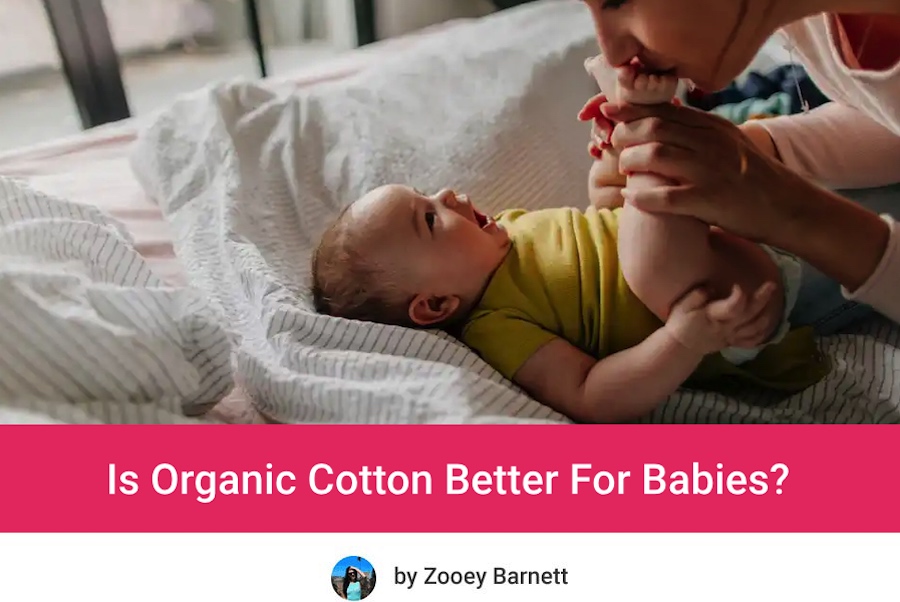
Did you know that more than 15% of all the world’s pesticides are used on conventional cotton crops? Even more disturbing, is that seven of the regularly-applied chemical pesticides used on cotton are linked to cancer.
This is some pretty scary stuff, especially when you think of the cotton material that is used in your baby’s clothes1.
Healthier fabric for baby’s delicate skin is just one of the reasons to reach for organic cotton over conventional cotton when shopping for baby products.
But, it can be hard to know what to look for when shopping. Sure, you want baby clothes that are cute and fit well, but if you’re also passionate about buying items that are eco-friendly and will hold up over time, the answers may not be as up-front as the clothing labels suggest they are.
Do you know the difference between products that are ‘made with organic cotton fibers’ and ones that are ‘certified organic cotton clothing’? Because they are NOT the same.
Or, do you now if bamboo fabric is a good alternative to organic cotton in terms of sustainability and being safe for baby’s skin?
This article will answer those questions and more, so you will understand if organic baby clothing is worth the hype and exactly what it takes to be certified organic cotton.
This article is not a substitute for medical advice or consultation.
What Is Organic Cotton?
Let’s take a look at how organic cotton is grown and what makes it different from non-organic cotton.
Organic Cotton Farming
Organic cotton is grown without any synthetic fertilizers, harmful pesticides or toxic substances.
Rules vary from country to country about what is require to be ‘certified organic cotton’, but in each case it requires third-party investigation of growing practices and crop treatment2. Some regulations state that the fields and area of growing must be free of chemicals for 3 years (minimum). This goes to show how long pesticides and fertilizers can remain in the soil3.
With organically-grown cotton, farmers may still apply natural, organic compost and utilize biological pest control (example: using ladybugs to eat unwanted pests, for example, instead of spraying chemicals)4.But the resulting raw cotton is grown without any synthetic additives or pesticides.
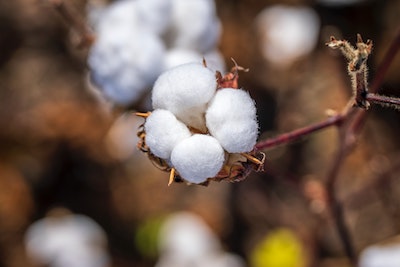
In most cases, growing organic cotton requires significantly less water consumption than other types of cotton, because organic fertilizers and compost help the soil retain moisture and it often results in less soil degradation than non-organic farming approaches, too.
This is better for the environment and makes for sustainable growing practices.
Organic Cotton Processing And Textile Industry
However, the differences between regular cotton and cotton that is grown organically is not only in the growing process, but the production process, as well.
Organic cotton clothing and other material that is certified organic should be produced without any synthetic dyes or harmful chemicals (including harsh dyes which can be dangerous to baby’s skin)5.
Not only is this better for babies and the environment, but the resulting material or clothing usually stands up over time better than synthetic fibers, such as polyester or rayon, too.
Color Vs. Dye
New advances support the use of ‘colored cotton’ which grows cotton bolls in specific colors, not only neutrals, but greens and yellows, too. And, it costs less than synthetically dyeing cotton later in production. This results in organic material that doesn’t risk baby’s exposure to harmful chemicals from dyes.
Actually, one of the governing bodies of organic clothing (the global organic textile standard, or GOTS) states that organic fibers should hold up over time, and naturally-colored cotton doesn’t fade with multiple washes like synthetic dyes do.
Final Product
With organically grown-and processed fabric what you get is:
- Very soft fabric l made without any synthetic materials or chemicals, which is better for the environment.
- Organic clothing made without toxins from dyes that are harmful to humans.
- Material that holds up over time and actually becomes softer with successive washes.
That makes for stronger baby socks, the softest baby blankets for swaddling and the most breathable organic cotton sleepwear, too.
What Is GOTS-Certified Organic Cotton?
Just because a product says it has organic fibers, please don’t be fooled. This does not exactly mean that the baby clothes are organic baby clothes, just that they have some organic threads in them somewhere.
I know it sounds confusing, but the best way to determine if baby’s ‘organic outfit’ is actually fully made of organic cotton (not just a small part here and there) is to check for a GOTS certificate on the label.
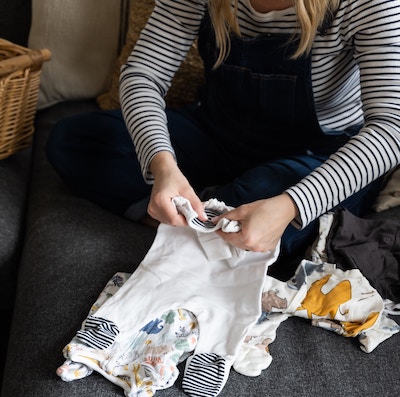
GOTS Certificate
GOTS stands for Global Organic Textile Standard. In order to meet the strict standards of this global certification, organic clothes must be:
- Made from at least 95% organic material (maybe the zippers or part of the lining, for example, is not organic, but the majority of the garment is).
- Made from cotton grown without any synthetic fertilizers or dangerous pesticides.
- Made from only natural dyes or safe synthetic dyes.
- Good quality and resistant to fading, shrinking over a reasonable amount of time.
- Use sustainable packaging.
Other Reasons To Choose Organic Clothes With GOTS Label:
For socially-conscious parents, another thing to consider with non-organic clothes is about how the humans in the textile industry at treated.
For a product to be officially GOTS certified organic clothing, it has to also meet the following requirements:
- Be made in a safe work environment for all workers.
- Never use child labor to create clothing.
- Pay workers a fair wage and humane working conditions.
As you can see, organic cotton is not just about the agricultural practices, but about raising awareness for the fair treatment of workers, too.
What Are The Benefits Of Organic Cotton Baby Clothes?
Not only is organic cotton better for babies, but there are other benefits to choosing organic items, some that you might not have considered before.
1. Better For Babies
For many parents, the most important benefit of organic baby clothing is that it is better for baby’s skin as well as for baby’s health.
Babies’ skin is more absorbent than adult skin, and they are more susceptible to chemical burns than adults (one of the reasons why babies cannot use adult sunscreen)
Since organic cotton uses no harsh synthetic chemicals or synthetic dyes in the production process, organic baby clothes are ideal for babies with:
- Skin sensitivities
- Skin irritation
- Eczema (here you can see my article with the best crib sheets for eczema babies)
2. Better For The Environment
If you are concerned about the environmental impacts of your products, then choose organic baby clothing as a more sustainable choice.
There is a huge environmental impact from the many dangerous chemicals used in the growing and production stages of non-organic cotton. Further, organic cotton requires less water than non-organic cotton does, making the choice for our planet pretty clear.
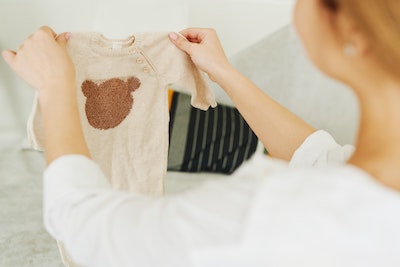
What Are The Cons Of Organic Cotton?
Organically grown cotton has some disadvantages, too:
1. More Expensive
Non-organic clothing is usually less expensive than organic cotton. That’s because farmers and manufacturers must pay, out of pocket for GOTS certification (it is not free), and they often have to pay more during growing and production because they are avoiding using toxic fertilizers or sprays.
2. Green Washing
‘Going green’ has become trendy, which means some brands try to ‘sell’ being green without actually having sustainable practices.
This shows up with some ‘organic clothing’ that is not certified and really only features a few sections of organic cotton, the entire piece should not be labeled ‘organic’. Make sure to check your ‘organic baby clothes’ to be sure you’re not being swindled and end up with your baby developing a nasty rash!
Is Organic Cotton Necessary For Baby?
No, organic cotton is not necessary for all baby clothes. Some babies do fine with conventional cotton clothing, but make sure to always wash baby clothes before use (even if they are new) because the harsh chemicals used during the production process may still be present.
If you find that your infant has sensitive skin or easily breaks out in rashes, you may want to consider making the switch to organic baby clothes in case of allergies or skin sensitivity.
If you have concerns that organic cotton might be scratchy or feel like low-quality wool or hemp material, please know this is inaccurate; organic cotton material is actually softer and more durable than regular cotton. Your baby’s clothes will hold up really well over time and not fade as quickly as conventional cotton items.
Make sure to read my article about drying baby clothes to keep them in good condition and avoid shrinking.
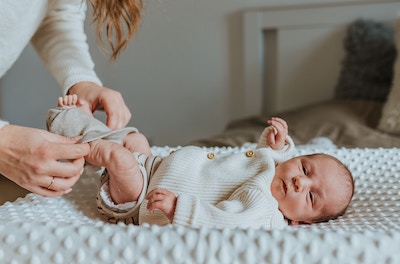
Conventional Cotton Vs. Organic Cotton – Key Differences
Here’s my comparison of organic and non-organic cotton.
1. Price
- Organic cotton:
It’s true, organic clothing is often more expensive than its conventional cotton counter-part.
When workers are given fair wages and the working conditions are safe, that means the end product will be more expensive – but at a price you can feel good about.
- Non-organic cotton:
In general, non-organic cotton (or regular cotton) children’s clothing is a more affordable option. But cheaper does not always mean better. As a consumer, it’s important to think of all the factors at play, environmental and societal, as well.
That’s not to say all non-organic cotton fabrics are made with inhumane practices and loaded with toxic chemicals. That would be a misrepresentation of some really great brands. The key here is to do your research and not purchase children’s clothing only based off of the price tag.
Dig deeper and learn about the environmental concerns, fair trade practices and potential use of toxic substances that may involved the creation of your infant’s clothes.
2. Breathability
- Organic cotton:
Organic cotton has been tested to be more breathable than regular cotton fabric. Since your baby needs superior breathability during summer months to help cool down their body temperature6, choosing organic cotton bedding and organic cotton clothes can be a major plus.
- Non-organic cotton:
When it comes to conventional cotton clothes, cotton is still a winner as a breathable fabric because it is made from natural fibers.
If it’s a choice between heavy rayon or synthetic fibers and cotton will always be the better option.
3. Environmental Awareness
- Organic cotton:
Some other benefits of organic cotton farming on the environment are that it requires less water consumption for production and protects the surrounding environment from run-off of harmful chemicals7.
- Non-organic cotton:
On the other hand, conventional cotton farming results in harmful pesticides and fertilizers leaking into the groundwater supply and rivers through run-off. This causes all sorts of issues with natural wildlife in the surrounding areas and disrupts the environment long-term.
Organic Cotton Vs. Bamboo – How Do They Differ?
Bamboo fabric has been suggested as a possible alternative to cotton8, but is it really better for the environment and healthier for your baby? Let’s look into how these organic fabrics compare:
1. Price
- Organic cotton:
In most cases, organic clothing made from cotton is more expensive than bamboo rayon – but bamboo rayon is not organic! Keep that in mind when comparing these two.
- Bamboo fabric:
There are several fabrics that can be derived from bamboo, including rayon and linen.
Bamboo linen is very expensive and labor-intensive to create. Bamboo rayon on the other hand is usually more affordable than organic cotton, but this material is not organic.
2. Sustainability
- Organic cotton:
Organic cotton uses less water than conventionally-grown cotton and doesn’t pose a threat to the environment by way of dangerous pesticides and chemical run-off. However, it does use more water than bamboo plants.
However, when the entire production process is taken into account, organic cotton still shines as the winner, because the manufacturing of cotton into fabric can be sustainable and organic, while bamboo fabric poses some problems.
- Bamboo fabric:
Bamboo is a wonderful plant that grows quickly, with minimal water. Bamboo can be used to make many household items, replace wood or building materials. While bamboo can be organically grown, the process to make bamboo fabric is not9.
Many chemicals are required to soften the woody texture and make it pliable to be used as cloth. It is during the production stage to make bamboo rayon or viscose that bamboo ceases to be ‘organic’.
Can Babies Wear Synthetic Clothes?
Synthetic fibers in general should be avoided for baby clothing, such as polyester.
Polyester is generally a poor choice for babies because it has low breathability (compared to natural fibers like wool or cotton that are breathable).
Further, it is a petroleum by-product which has many implications, including possibly leaking microplastics – yuck! Instead of synthetic materials, choose organic baby clothes.
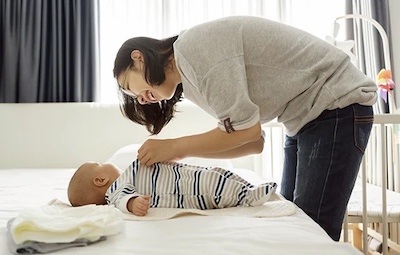
What Cotton Is Best For Baby Clothes?
Organic cotton is best for children’s clothes because it actually gets softer with multiple washes, and it must be a of high quality to stand up to standard wear-and-tear (which your toddler will certainly do!).
Other reasons to love organic cotton for baby clothes:
- Incredibly soft for baby’s sensitive skin
- Hypoallergenic
- Made without toxic chemicals (so I know its healthier for my baby, too)
- It’s a natural fiber that is breathable
Also, I feel good about purchasing items that at GOTS certified organic cotton, because I know I am supporting fair-trade practices and making a more sustainable choice with my purchase.
Toxic Chemicals That Can Be Found In Conventional Fabrics
There are some really nasty things lurking on fabrics! They make their way onto all types of fabric, including children’s clothes10, during the growing, manufacturing or shipping and packaging process.
There are far too many to name in this article, but some of the most concerning ones include:
- NPE (Nonylphenol ethoxylate) – While this is banned in the USA, it is not banned in China, where the majority of US clothes are made. Some of the US top clothing brands (non-organic) were found to have traces of this chemical on their fabrics.
- Formaldehyde – It supposed to prevent wrinkles or rot from unintended moisture. While it is clearly linked to cancer, the US regulates this chemical only for hygiene or food products, not in clothes.
- PFC (Perfluorinated chemicals) – Similar to formaldehyde, this toxin keeps clothes from wrinkling and is linked to ‘forever chemicals’ because they do not break down over time.
- Synthetic dyes that use heavy metals – W all know, babies will chew on their clothes, so this is pretty scary for me as a mom. Some of the specific types to avoid are known as AZO dyes.
Toxic chemicals can be present on clothing in so many ways, it is important to take care when choosing items for your baby or toddler. Besides checking to see if an item is organic certified, it’s a good idea to also look for a OEKO-TEX label.
What Is OEKO-TEX Certified?
This is an independent body that tests products for substances that pose a risk to human health.
For an item to be certified as ‘safe’ by OEKO-TEX, every part – including buttons and zippers – will be checked for harmful substances. If it’s found clear, it will get this prestigious label.
Final Decision: Is Organic Cotton Better For Babies Than Other Fabrics?
While it can feel dizzying to choose the best (and cutest!) clothes for your little one, keep in mind that certified organic cotton is a great choice because it is hypoallergenic, safe for baby’s skin, better for the environment and doing good in the world, too.
Whenever possible, choose organic baby clothes for your little one and feel good about your purchases.
The purpose of this article is informative. It’s not a substitute for professional medical advice or medical care. Remember: safety first! Consult your doctor/pediatrician in case of any doubts. The author of this article does not accept any responsibility for any liability, loss or risk, personal or otherwise, incurred as a consequence, directly or indirectly, from any information or advice contained here.
Resources:
https://attra.ncat.org/
https://www.fibre2fashion.com/
https://www.sciencedirect.com/
https://www.happiestbaby.com/
https://www.lepetitsociety.com/

